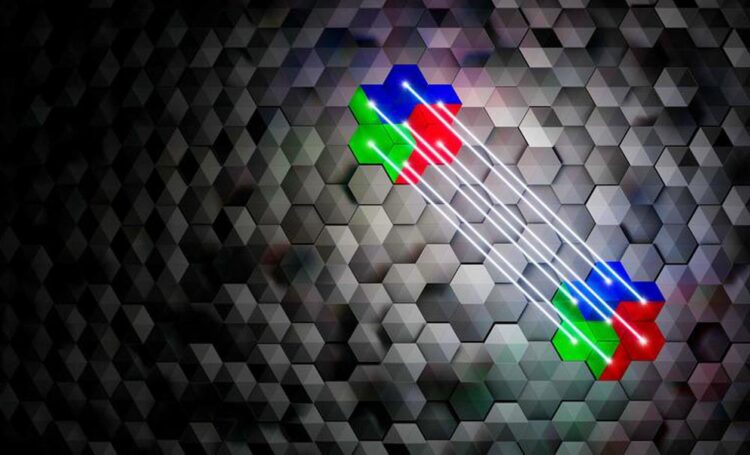Error-Free Quantum Computing Gets Real

Artist impression of gate operations on logical quantum bits, that are protected from faults by means of quantum error correction.
(c) Johannes Knünz
For quantum computers to be useful in practice, errors must be detected and corrected. At the University of Innsbruck, Austria, a team of experimental physicists has now implemented a universal set of computational operations on fault-tolerant quantum bits for the first time, demonstrating how an algorithm can be programmed on a quantum computer so that errors do not spoil the result.
In modern computers errors during processing and storage of information have become a rarity due to high-quality fabrication. However, for critical applications, where even single errors can have serious effects, error correction mechanisms based on redundancy of the processed data are still used.
Quantum computers are inherently much more susceptible to disturbances and will thus probably always require error correction mechanisms, because otherwise errors will propagate uncontrolled in the system and information will be lost. Because the fundamental laws of quantum mechanics forbid copying quantum information, redundancy can be achieved by distributing logical quantum information into an entangled state of several physical systems, for example multiple individual atoms.
The team led by Thomas Monz of the Department of Experimental Physics at the University of Innsbruck and Markus Müller of RWTH Aachen University and Forschungszentrum Jülich in Germany has now succeeded for the first time in realizing a set of computational operations on two logical quantum bits that can be used to implement any possible operation. “For a real-world quantum computer, we need a universal set of gates with which we can program all algorithms,” explains Lukas Postler, an experimental physicist from Innsbruck.
Fundamental quantum operation realized
The team of researchers implemented this universal gate set on an ion trap quantum computer featuring 16 trapped atoms. The quantum information was stored in two logical quantum bits, each distributed over seven atoms. Now, for the first time, it has been possible to implement two computational gates on these fault-tolerant quantum bits, which are necessary for a universal set of gates: a computational operation on two quantum bits (a CNOT gate) and a logical T gate, which is particularly difficult to implement on fault-tolerant quantum bits. “T gates are very fundamental operations,” explains theoretical physicist Markus Müller. “They are particularly interesting because quantum algorithms without T gates can be simulated relatively easily on classical computers, negating any possible speed-up. This is no longer possible for algorithms with T gates.” The physicists demonstrated the T-gate by preparing a special state in a logical quantum bit and teleporting it to another quantum bit via an entangled gate operation.
Complexity increases, but accuracy also
In encoded logical quantum bits, the stored quantum information is protected from errors. But this is useless without computational operations and these operations are themselves error-prone. The researchers have implemented operations on the logical qubits in such a way that errors caused by the underlying physical operations can also be detected and corrected. Thus, they have implemented the first fault-tolerant implementation of a universal set of gates on encoded logical quantum bits. “The fault-tolerant implementation requires more operations than non-fault-tolerant operations. This will introduce more errors on the scale of single atoms, but nevertheless the experimental operations on the logical qubits are better than non-fault-tolerant logical operations,” Thomas Monz is pleased to report. “The effort and complexity increase, but the resulting quality is better.” The researchers also checked and confirmed their experimental results using numerical simulations on classical computers.
The physicists have now demonstrated all the building blocks for fault-tolerant computing on a quantum computer. The task now is to implement these methods on larger and hence more useful quantum computers. The methods demonstrated in Innsbruck on an ion trap quantum computer can also be used on other architectures for quantum computers.
Financial support for the research was provided, among others, by the European Union within the framework of the Quantum Flagship Initiative as well as by the Austrian Research Promotion Agency FFG, the Austrian Science Fund FWF and the Federation of Austrian Industries Tyrol.
Wissenschaftliche Ansprechpartner:
Lukas Postler
Department of Experimental Physics
University of Innsbruck
T +43 512 507- 52554
E lukas.postler@uibk.ac.at
W https://quantumoptics.at/
Markus Müller
Institute for Quantum Information
RWTH Aachen
T +49 241 80 28412
E m.mueller@physik.rwth-aachen.de
W https://markus-mueller.website/
Originalpublikation:
Demonstration of fault-tolerant universal quantum gate operations. Lukas Postler, Sascha Heußen, Ivan Pogorelov, Manuel Rispler, Thomas Feldker, Michael Meth, Christian D. Marciniak, Roman Stricker, Martin Ringbauer, Rainer Blatt, Philipp Schindler, Markus Müller, and Thomas Monz. Nature 2022 doi: 10.1038/s41586-022-04721-1 https://www.nature.com/articles/s41586-022-04721-1 [https://arxiv.org/abs/2111.12654]
Media Contact
All latest news from the category: Information Technology
Here you can find a summary of innovations in the fields of information and data processing and up-to-date developments on IT equipment and hardware.
This area covers topics such as IT services, IT architectures, IT management and telecommunications.
Newest articles

Innovative 3D printed scaffolds offer new hope for bone healing
Researchers at the Institute for Bioengineering of Catalonia have developed novel 3D printed PLA-CaP scaffolds that promote blood vessel formation, ensuring better healing and regeneration of bone tissue. Bone is…

The surprising role of gut infection in Alzheimer’s disease
ASU- and Banner Alzheimer’s Institute-led study implicates link between a common virus and the disease, which travels from the gut to the brain and may be a target for antiviral…

Molecular gardening: New enzymes discovered for protein modification pruning
How deubiquitinases USP53 and USP54 cleave long polyubiquitin chains and how the former is linked to liver disease in children. Deubiquitinases (DUBs) are enzymes used by cells to trim protein…



